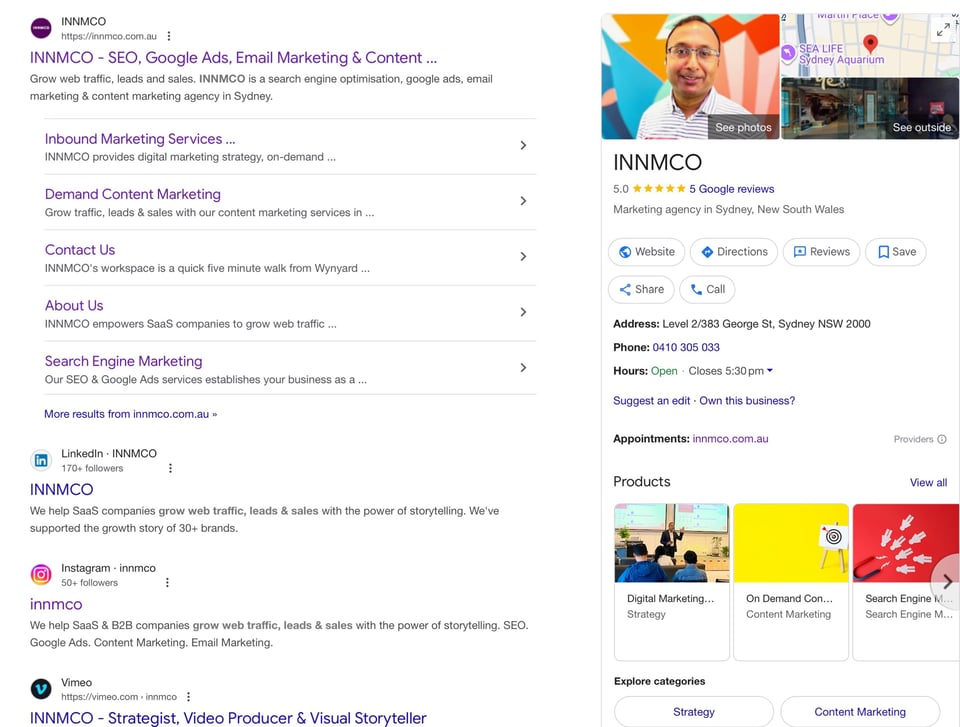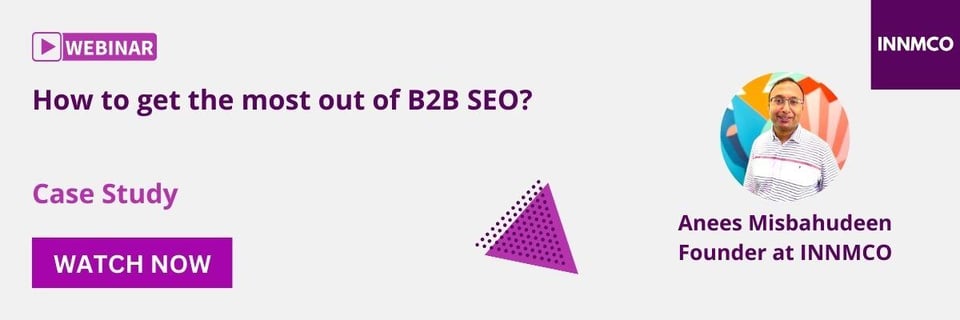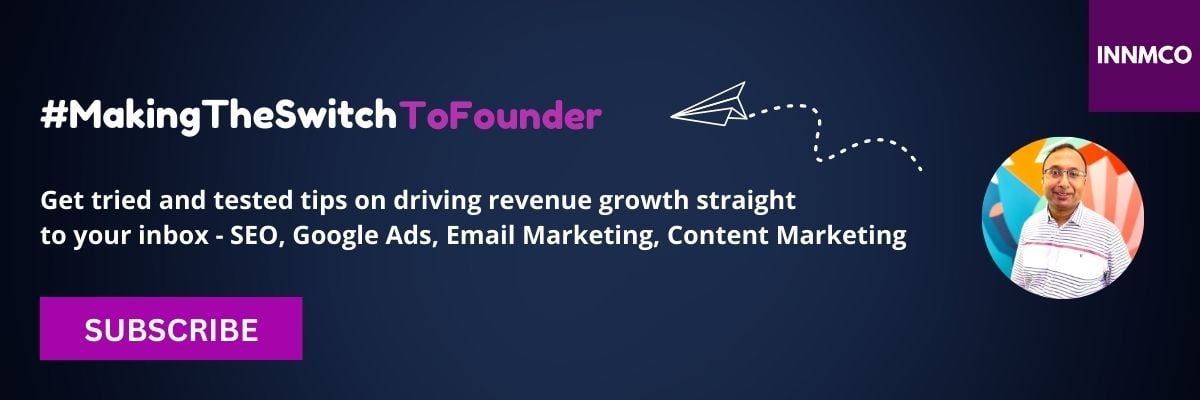Updated on: September 03, 2025
SEO Strategy
I wanted to acquire organic search traffic and generate quality leads for my digital marketing business. Here are my nine steps for creating and implementing an SEO strategy for my digital marketing business website.
Table of Contents
1. Clarity on product positioning & messaging
2. Select a content management system
3. Create high quality content
4. Choose keywords
5. Implement on-page SEO
6. Implement technical SEO
7. Create a google business profile
8. Obtain high quality backlinks
9. SEO Tools - Google Search Console
10. Case Study - How to get the most out of B2B SEO?
1. Clarity on your value proposition, positioning and messaging to your customer
You implement
search engine optimisation (SEO) strategies to let your prospective customer know about your expertise, your skills and how you can solve their problems better than anyone else.
If you are not very clear on your business goals, product positioning or messaging of your value proposition in market, this gets reflected in your SEO strategy and SEO implementation. You will have limited success in your search rankings.
Example - I initially started my business with a view to solve a particular problem for a particular target market. I kept adding many services. I started to spread myself very thin across multiple service areas. This led to a conflicting messaging with my target audience on my specialisation areas.
I took my value proposition for testing with my target market and got very direct feedback on how our service offering was potentially perceived by my target audience. This helped me to make amends to my value proposition, my service positioning and messaging.
2. Choose the right content management system for your website
I wanted to build a website for my business. I signed up for a website builder tool to start this process. I wasn’t quite aware of the website builder tool’s search engine optimisation (SEO) capabilities. I built and launched my website using this tool.
Over time, I realised that the website builder tool had many limitations including the ability to implement SEO strategies for blog posts. I changed my website builder tool, as it was stifling me from implementing my SEO strategy for my business.
Our digital marketing agency considered the below factors while shortlisting a CMS tool for our business:
1. The ability to log into one platform to manage websites, blogs, landing pages, forms, email marketing and leads.
2. Access to advanced CMS capabilities as the business grows. These advanced capabilities include advanced SEO, marketing automation and additional website pages.3. CMS integration with the CRM. The CMS should have the capability to sent leads to the CRM.4. CMS integration with other marketing tools like email marketing. This would enable us to nurture leads from website, blogs and landing pages.5. User experience.6. Price of the CMS.
Read our blog to learn more about my step by step process of building a website on HubSpot CMS.
Evaluate SEO capabilities of your content management system prior to making an investment decision. This is key to implementing a SEO strategy for your website.
3. Create high quality content for your target audience
It all comes down to quality of your content or blog post. Make your content as useful as possible for your target audience. Write your blog post or create your content, in a way that speaks to your target audience. Your content needs to address a problem that they are facing.
Start with a buyer research to learn more about buyer needs, goals and challenges. Interview prospective buyers to understand what channels they use (e.g. search, social, email, friends) to find information that addresses their needs. Learn more about what content types (e.g. blogs, videos) resonate with your prospective buyer.
Create content that addresses the needs, goals and challenges of your target buyer. This will increase the likelihood of your readers clicking on your link and reading your article or blog post. The better the quality of your article, the more the likelihood that associated keywords for a page get a higher rank on google search engine results page (SERPs).
Your pages get shown higher in search results. This increases the likelihood of your prospective buyer clicking on your link and reading your page or blog post.
4. Choose the right keywords to represent your products or services or content
Your ranking on search engine results page (SERPs) includes many ranking factors which we will go through in this blog and other blogs on search engine optimization (SEO). A ranking factor includes your choice of keywords and how you implement them for your web page or blog post.
Choose the right keywords keeping in view search volumes, keyword difficulty and search intent (whether it is an information, navigational, transactional or a commercial keyword). Consider using long tail keywords as well. Use a keyword research tool like Semrush or ahrefs to do your keyword research. Create lists of keywords. Implement on-page SEO.
Include factors like competitive density (the level of competition between advertisers bidding for a keyword in their pay per click campaigns) and cost per click, if you plan on implementing pay per click campaigns for your product or service.

5. Implement on-page SEO
Implement on-page SEO on completing keyword research. Include relevant keyword in your page headline, title, meta description, body of the page etc. The intent is not to stuff keywords everywhere, as google penalises you for this.
The intent is to make your page informative for your target audience while incorporating keywords that your target audience may use in their search queries or search terms.
The below is a list of on-page SEO factors to consider
1. Page title - Make your title as informative as possible for your target audience. Incorporate keywords keeping in view the relevance of your keyword to the content and the terms that your target audience searches for.
2. Page header - Your page headline should convey to the user what your page is about. Incorporate your keyword in your page header, where ever possible.
3. Meta descriptions - Include a description of what your page is about. Incorporate your keywords in a way that makes the page description as informative as possible for your target audience. Utilise keywords that your target audience searches for.
4. Alternative text for images - Include an alternative text for the images used in a page. This helps google crawlers understand what your image is about.
5. Page URLs - Your url should convey to the user what your page is about. Try incorporating your keyword in your url.
6. Internal linking of pages - Link pages to each other. This should be done keeping in view your website architecture and the flow that you want your users to take while they arrive at a page in your website.
See examples on how to implement on-page SEO.
6. Implement technical SEO
Do a technical SEO audit. The main objective of a technical SEO audit is to ensure that search engines can crawl, index and rank pages on your site. Use tools like SEMrush or Ahrefs to do site audits. This will give you a full list of errors that you should fix on your website.
Some technical SEO factors include - broken links on a page, orphaned pages, page speed, mobile friendly site, SEO friendly url structure, duplicate content etc. Contact our SEO experts, if you want to get a SEO audit for your business website.
Implement structured data. Structured data helps search engines better understand page content. Adding structured data mark up code will enable your pages to win rich snippets. Rich snippets are more appealing in search results (e.g. reviews). Your pages stand out in SERPs. Rich snippets increases the click through rate for your pages.
7. Setup your google business profile
Make sure your business has a google business profile (formerly known as google my business). A google business profile provides some information about your business to your prospective customers. You are able to enter information about your products and services, your working hours, address, website , contract information etc. You can also post updates about your business.
This enables your prospective customers to find your business, get more information about what you do and write reviews on your company’s products or services.
Online business without a physical presence can also have their information displayed. It is imperative to maintain contact with your customers. A google business profile can be created for free.

8. Build high quality backlinks to your website
In the physical world people refer ‘other people’ who they trust for opportunities like projects, jobs etc. In the website world, this equates to websites linking to ‘certain pages on other websites’ who they trust.
You may have written an article that is considered trustworthy and another website includes a link to your article. You may have delivered an outstanding service and another website includes a link to your product or service page.
Link building is a bit more harder to execute, as trust is something that you earn over time. Building trust with your prospective customers is crucial to doing business and building a business that stands the test of time.
9. Use tools like google search console
Google Search Console is a free tool from google with many capabilities. I use this tool to get a view on how my web pages are performing in search. You get insights into top search queries for which your pages appear in Google SERPs. This information can be used to implement targeted keywords during your on-page SEO activity.
Google search console also provides information on number of impressions, clicks, click through rate and average position of your web pages. You can use this tool to submit your sitemap, identify pages that have issues etc.
Eight ways to promote your business online
Now that you are on your way to implementing a SEO strategy for your website. How do you go about promoting your business online?
As an entrepreneur, I wanted to build trust with my buyer by addressing their needs at different stages in the buyer’s journey. I also wanted to raise brand awareness and generate quality leads. In this blog, I share eight areas to focus while promoting your business online.
Start by creating a digital marketing strategy for your business. Consider popular digital channels like website, search, social media and emails. Organise leads in a CRM. Choose an integrated sales and martech stack to minimise the challenges associated with managing multiple systems.
Conclusion
Prototype and test your value proposition, product positioning and messaging with your target audience. A poor value proposition, product positioning and messaging will get reflected in your SEO results.
Choose the right content management system for your website. This provides a firm technical foundation for implementing a search engine optimisation strategy for your business website.
Choose the right keywords. Implement on-page SEO and technical SEO. Setup your google business profile. Build high quality backlinks to gain more credibility. Use tools like google search console while implementing a SEO strategy for your website.
Read why B2B SEO is important for your business and how to build an effective content marketing funnel.

Grow web traffic, leads & sales!
Founder & Digital Marketing Director, INNMCO
.png?width=200&height=125&name=Anees%20Misbahudeen%20-%20Company%20Profile%20(700%20%C3%97%20436%20px).png)
I’m a search engine optimisation and google ads consultant based in Sydney, Australia. I help SaaS companies grow their web traffic, leads, and sales through the power of story telling. As the founder and Digital Marketing Director of an SEO agency and PPC advertising agency in Sydney, I specialise in search engine optimisation services, Google Ads services and content marketing services. I help brands maximise ROI through organic search and paid search. With over 10 years of experience, I’ve supported the growth of 30+ brands across industries such as software, financial services, automotive and startups —driving measurable results through strategic digital marketing.

Share




.png?width=200&height=125&name=Anees%20Misbahudeen%20-%20Company%20Profile%20(700%20%C3%97%20436%20px).png)
.png?width=75&height=75&name=INNMCO%20Company%20Logo%20-%202025%20(700%20x%20700%20px).png)

.png)





